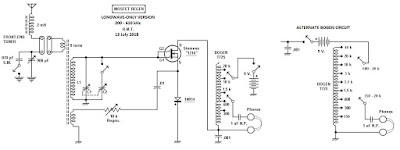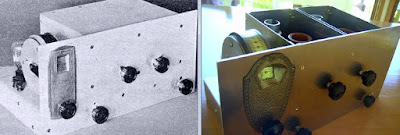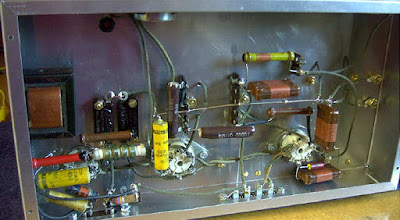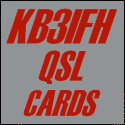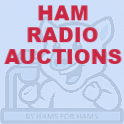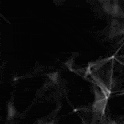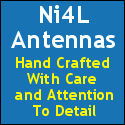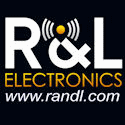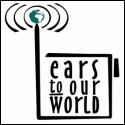Posts Tagged ‘regenerative’
 Barn Door CLE Regen Results
Barn Door CLE Regen Results

This past weekend's 'Barn Door' CLE' saw a lot of participation, in spite of the mid-summer doldrums and the universal nasty lightning noise.
After reading CLE-organizer Brian Keyte's interesting posting to the ndblist, describing his homebrew single transistor regenerative receiver, I was inspired enough to dig out the soldering iron and build one for myself.
The circuit widely described as a '1AD regen' was originally designed several years ago by crystal-radio guru Mike Tuggle out in Hawaii. Mike is widely known for his exquisitely designed "Lyonodyne" DX crystal radio, which inspired an entire decade of intense DX crystal radio building activity back in the late 90's.
 |
| Mike Tuggle's 'Lyonodyne' DX Crystal Radio |
His '1 Active Device' medium-wave regen consists of a handful of simple components and a MOSFET that is up to the task. His design was, and still is, being duplicated by many throughout the NDB DX listening community.
 |
| Mike's original 1AD regen |
Mike recently sent me the circuit diagram that he eventually settled with, showing two possible ways of extracting audio with the widely popular Bogen T725 output transformer.
My own version used Mike's output scheme on the right and the RF circuitry in Roelof Bakker and Steve Ratzlaff's modified version, shown below. I had to increase the tickler (feedback) winding from 4 turns to 11 turns in order to get any regeneration. With 11 turns, my regeneration kicked-in at about three-quarters from the end of the regen control. At some point in time, while testing, some of the leads from my Bogen T725 output transformer momentarily brushed against each other, smoking my FET. Upon replacing it with another BF966, the receiver was much hotter, with regeneration kicking-in very close to the start of the pot. I'm not sure if the first FET was already damaged or that there is enough variation from FET to FET (of the same type) to make some have more gain than others. Accidentally blowing up the FET proved beneficial in the end!
Although most users employ sensitive sound powered headphones with their regens, including myself, some use modern phones with an extra stage of audio, such as an LM386.
Although not nearly as pretty as Mike's regen, my own 1AD was built in an afternoon, just for the recent Barn Door CLE.
 |
| My own MW 1AD regen |
I later added a calibrated dial plate, breaking the segment from 200kHz to 550kHz into two separate bands, with calibration ~ +/- 1kHz so that I pretty much new where I was tuning at all times. This allowed me to target specific beacons and wait for them to fade up.
When first published, Mike suggested the BF966 MOSFET seemed to work well and I purchased five of them with the intention of someday building a 1AD for the NDB band. The purchase came in handy, as today, the BF966 is no longer available. Apparently the similar, and still available BF998 works well (from tests done by Steve Ratzlaff) but is now in an SMD package at just 18 cents! No doubt there are dozens of MOSFETS that will do the job and at these prices, experimenting with various devices would be a very worthwhile project.
When operating, the regen proved to be surprisingly sensitive, and by using my 10' x 20' loop, I was able to put my local pest (AP-378 kHz and 1/2 mile away) into a deep null so that its huge signal was no longer blocking the top half of the NDB band. The null allowed me to hear beacons within a few kHz of the blowtorch signal as shown below:
------------------------------------------
DD UTC kHz Call Location
------------------------------------------
28 05:15 200 YJ Victoria, BC, CAN
28 05:15 203 YBL Campbell River, BC, CAN
28 05:21 214 LU Abbotsford, BC, CAN
28 11:10 218 PR Prince Rupert, BC, CAN
28 11:07 221 QU Grande Prairie, AB, CAN
28 05:30 223 YKA Kamloops, BC, CAN
28 05:36 227 CG Castlegar, BC, CAN
28 05:38 230 YD Smithers, BC, CAN
28 11:04 233 ALJ Hinchinbrook Island, ALS
28 05:42 236 YZA Ashcroft, BC, CAN
30 10:06 239 OJ High Level, AB, CAN
28 05:42 240 BVS Burlington, WA, USA
30 10:04 241 YLL Llyodminster, AB, CAN
28 05:44 242 ZT Port Hardy, BC, CAN
29 11:27 242 XC Cranbrook, BC, CAN
29 11:26 246 ZXJ Fort St. John, BC, CAN
30 10:21 248 QH Watson Lake, YT, CAN
28 05:43 251 YCD Nanaimo, BC, CAN
29 11:20 254 ZYC Calgary, AB, CAN
30 09:56 254 SM Fort Smith, AB, CAN
28 05:50 257 LW Kelowna, BC, CAN
30 09:54 257 XE Saskatoon, SK, CAN
28 10:55 260 YSQ Atlin, BC, CAN
28 05:50 266 VR Vancouver, BC, CAN
30 09:50 269 ZW Teslin, YT, CAN
28 05:51 272 XS Prince George, BC, CAN
28 10:47 283 DUT Dutch Harbor, ALS
28 06:06 284 FHR Friday Harbor, WA, USA
30 09:35 284 QD The Pas, MB, CAN
28 10:39 287 PE Peace River, AB, CAN
28 06:07 290 YYF Penticton, BC, CAN
28 06:07 293 MB Sidney, BC, CAN
28 10:39 295 8C Fairview, AB, CAN
28 10:39 299 TV Turner Valley, AB, CAN
28 06:11 312 UNT Naramata, BC, CAN
28 06:14 325 YJQ Bella Bella, BC, CAN
28 06:16 326 DC Princeton, BC, CAN
29 11:08 326 XJ Fort St. John, BC, CAN
28 06:16 332 WC White Rock, BC, CAN
28 06:18 338 K Port Angeles, WA, USA
29 11:06 338 ZU Whitecourt, AB, CAN
29 11:05 341 DB Burwash, YT, CAN
28 06:19 344 XX Abbotsford, BC, CAN
30 09:08 348 MNC Shelton, WA, USA
28 06:20 350 NY Enderby, BC, CAN
28 10:25 356 ON Penticton, BC, CAN
30 09:03 356 ZF Yellowknife, NT, CAN
28 06:20 359 YQZ Quesnel, BC, CAN
28 10:20 362 RPX Roundup, MT, USA
28 10:17 362 BF Seattle, WA, USA
28 06:22 368 ZP Sandspit, BC, CAN
29 10:17 368 SX Cranbrook, BC, CAN
29 10:31 374 EX Rutland, BC, CAN
29 10:31 375 FS Fort Simpson, NT, CAN
28 06:20 378 AP Active Pass, BC, CAN
28 06:26 382 YPW Powell River, BC, CAN
29 10:37 382 YE Fort Nelson, BC, CAN
28 06:23 385 WL Williams Lake, BC, CAN
29 10:39 388 MM Fort Mc Murray, AB, CAN
28 06:41 389 YWB Kelowna, BC, CAN
29 10:42 394 DQ Dawson Creek, BC, CAN
29 10:44 397 ZSS Yellowhead, SK, CAN
29 10:48 398 YOD Cold Lake, AB, CAN
28 06:28 400 QQ Comox, BC, CAN
28 06:28 404 MOG Montegue, CA, USA
29 10:49 405 2K Camrose, AB, CAN
29 10:16 406 YLJ Meadow Lake, SK, CAN
28 06:29 408 MW Moses Lake, WA, USA
29 10:53 414 8M Elk Point, AB, CAN
28 20:00 515 CL Cresent Beach, WA, USA
I ended up with 70 stations logged, including a couple of Alaskans, in spite of the horrendous lightning noise on all three nights. Doing another 'Barn Door CLE' in the middle of the quiet DX season would be much more exciting and several 1AD users have indicated an appetite for such an event. If you put something together please let me know as having an army of 1AD's ready to go would be a great incentive to schedule another Barn Door weekend!
 1933 Regen Project
1933 Regen Project
 Monday was spent finishing the coil winding for my present bench project, a 3-tube regenerative receiver. The receiver first appeared in the January '33 QST article, "Rationalizing The Autodyne", by George Grammer. I tried to stay true to the original design, both physically and electrically, as much as possible. Where period components were not available, they were manufactured. Several capacitor are 're-stuffed' cases and some resistors have been physically altered to resemble era-appropriate styles. The one deviation I made from the original circuit was to remove the B+ (200VDC) from the headphones by going to impedance-coupled audio, which blocks DC from the headphone circuit. After finishing the coils and doing a quick re-check of the wiring, I held my breath and applied the power.
Monday was spent finishing the coil winding for my present bench project, a 3-tube regenerative receiver. The receiver first appeared in the January '33 QST article, "Rationalizing The Autodyne", by George Grammer. I tried to stay true to the original design, both physically and electrically, as much as possible. Where period components were not available, they were manufactured. Several capacitor are 're-stuffed' cases and some resistors have been physically altered to resemble era-appropriate styles. The one deviation I made from the original circuit was to remove the B+ (200VDC) from the headphones by going to impedance-coupled audio, which blocks DC from the headphone circuit. After finishing the coils and doing a quick re-check of the wiring, I held my breath and applied the power.Much to my surprise and delight, the receiver worked immediately. It took me some time to find the correct control settings and combinations that seemed best but eventually its operation became familiar. Here are a couple of short recordings, crudely made via connecting the computer across the high-impedance headphones, as I tuned across a somewhat noisy 40m band in the evening.
Now although the receiver appears to be working, I'm not 100% convinced that it is working as well as it should. It's difficult to know exactly how it should perform when at its best as it really can't be compared to any of our modern-day receiving systems. Just what did 'good performance' sound like in 1933?
I have some reservations about one of my tubes. It's a '78' from my junk-box stash and has a large red '?' inked across the glass envelope. I may order some NOS '78's or even some more modern '6D6's, to see how they perform. On the plus side, the oscillator seems very stable and there is absolutely no 'hand-effect' on tuning, a common problem with many regens. Peaking up the RF stage tuning causes no pulling of the oscillator but the '78', although a hot-performer in 1933, provides plenty of tube noise as well, if the gain is set too high. I think the main advantage of having the tuned RF stage is to add RF selectivity and eliminate any bleed-through from some of the blowtorch shortwave signals just up the band. Tuning seems best when its gain is set between fifty and seventy-five percent of maximum. The large drum dial, in combination with the small bandspread capacitor, spreads 40m across most of the dial and makes for easy tuning although there is a small amount of backlash.
Another thing I noticed is that it seems to be very receptive to spurious computer birdies, with the laptop sitting just a foot away. Perhaps its unshielded top and bottom are the cause of this as I don't hear any of the signals on my main station receiver.
Comparing it to the two-tube regen in my Paraset, the Paraset sounds much quieter and generally sounds more sensitive ... but it uses more modern tubes, '6SK7's, first introduced in 1938, five years after the '78'. The selectivity seems as good, if not better, than the Paraset, which I consider an excellent performer. The Paraset also sounds just as good as my National SW-3, which was produced in the early 30's ... so the new regen is likely not as quiet nor as sensitive as the SW-3, probably the best simple regen of its day.
Perhaps some newer tubes will make a difference in performance and maybe my expectations are too high. In any event, the closing paragraph of Grammer's article may be more telling that I originally thought:
"The set as it stands is not perfect, of course; nothing ever is."
